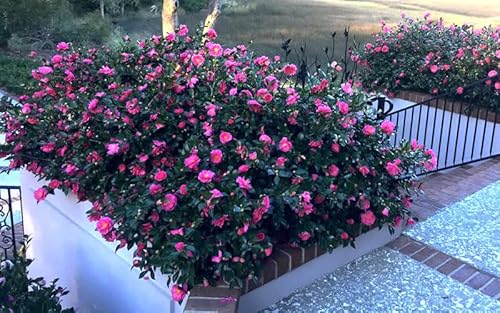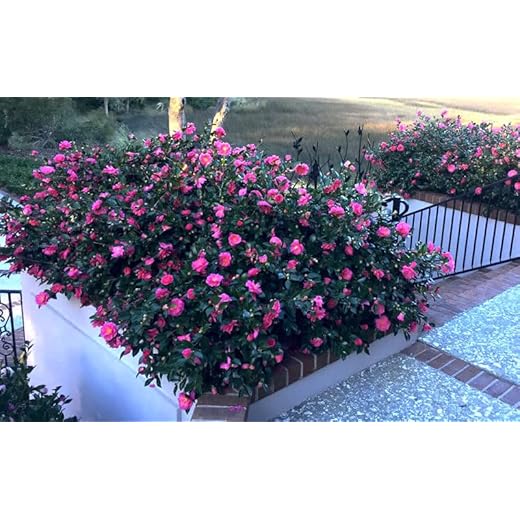


Camellias are beautiful flowering plants that can be transformed into stunning bonsai trees. With their glossy leaves and delicate flowers, camellias make for an excellent choice when it comes to creating a bonsai masterpiece. However, turning a camellia nursery stock into a bonsai requires careful pruning and shaping techniques.
Firstly, it is important to select a healthy camellia plant from a reputable nursery. Look for a specimen with a thick trunk and well-developed branches. Ideally, the plant should already have a natural bonsai-like appearance. If not, don’t worry, as you can shape it over time.
Next, carefully remove the camellia from its nursery container and gently loosen the roots. Trim any excessively long or damaged roots, being cautious not to prune too much. Afterward, place the camellia in a bonsai pot filled with well-draining soil mix. Make sure to position the tree slightly off-center for a more natural and aesthetically pleasing look.
Once potted, it’s time to begin the training process. Start by pruning the branches back to maintain a balanced shape. Remove any crossing or weak branches, as well as those that interfere with the desired bonsai design. Use sharp bonsai shears to make clean cuts and prevent damage to the tree.
Choosing Camellia Nursery Stock for Bonsai: Essential Tips
When it comes to creating a stunning bonsai from camellia nursery stock, selecting the right tree is crucial. Here are some essential tips to help you choose the best camellia nursery stock for your bonsai project:
- Size: Look for camellia nursery stock that is small in size. Bonsai trees should be compact and have a balanced shape, so selecting a young camellia with a smaller trunk diameter is ideal.
- Branching: Examine the branching structure of the camellia nursery stock. Ideally, you want a tree that has low side branches and a well-defined central trunk. This will make it easier to shape and train your bonsai.
- Taper: Check if the camellia nursery stock has a natural taper from the base of the trunk to the top. A tree with a gradual decrease in trunk diameter will give your bonsai a more realistic and aged appearance.
- Roots: Inspect the roots of the camellia nursery stock. Look for a tree with a well-developed root system. The roots should radiate evenly from the base and should not have any large, circling roots. A healthy root system is essential for the long-term health of your bonsai.
- Health: Choose camellia nursery stock that is healthy and free from pests and diseases. Inspect the leaves for signs of discoloration, wilting, or pests. Avoid any trees that show signs of poor health, as they may struggle to thrive as bonsai.
- Trunk Movement: Consider the trunk movement of the camellia nursery stock. Look for a tree with an interesting and graceful trunk shape. Avoid trees with straight or awkwardly bent trunks, as they may limit the aesthetic appeal of your bonsai.
By considering these essential tips, you can choose the perfect camellia nursery stock to create a beautiful and thriving bonsai. Remember, patience and careful selection are key in the journey of bonsai cultivation.
Step-by-Step Guide to Bonsai from Camellia Nursery Stock
Creating a bonsai from camellia nursery stock can be a rewarding and fulfilling project for any enthusiast. With the right techniques and care, you can transform a regular camellia plant into a beautiful bonsai tree. Here is a step-by-step guide to help you get started:
1. Selecting the Nursery Stock
The first step is to choose a healthy camellia plant from a nursery. Look for a plant with a strong trunk, well-developed branches, and dense foliage. It’s important to select a nursery stock that has potential for bonsai styling.
2. Pruning and Shaping
Once you have selected the nursery stock, the next step is to prune and shape it. Remove any unwanted branches and foliage to create a desired shape for your bonsai. Use pruning shears or bonsai wire to carefully shape the branches. Remember to maintain the overall balance and harmony of the tree.
3. Repotting
After pruning and shaping, it’s important to repot the camellia nursery stock into a suitable bonsai pot. Choose a pot that is slightly larger than the plant’s root ball to allow for growth. Use well-draining bonsai soil and make sure to properly secure the plant in the pot.
4. Training and Wiring
Training and wiring the branches is a crucial step in creating a bonsai from camellia nursery stock. Use bonsai wire to gently guide and shape the branches into desired positions. Be careful not to damage the branches or restrict the natural growth of the plant. Regularly check the wire and adjust as needed.
5. Watering and Fertilizing
Proper watering and fertilizing is essential for the health and growth of your bonsai. Camellia bonsai prefer moist soil, but avoid overwatering as it can lead to root rot. Check the moisture level of the soil regularly and adjust the watering accordingly. Apply a balanced bonsai fertilizer during the growing season to promote healthy growth.
6. Pruning and Maintenance
Maintaining the bonsai by regular pruning is necessary to control its size and shape. Trim back new growth and remove any dead or unhealthy branches. Keep an eye out for pests and diseases, and treat them promptly to protect the bonsai. Regularly check the wiring and adjust if necessary to prevent wire cutting into the branches.
With patience and dedication, your camellia nursery stock can be transformed into a stunning bonsai tree. Follow these steps and enjoy the art of bonsai cultivation!
Camellia Bonsai: Selecting the Right Variety
When it comes to creating a camellia bonsai, selecting the right variety of camellia is crucial. Not all camellias are suitable for bonsai cultivation, so it’s important to choose a variety that has the necessary characteristics for bonsai training.
One of the key factors to consider when selecting a camellia variety for bonsai is its growth habit. Ideally, you should look for camellias that have a compact and slow-growing nature. These types of camellias are better suited for bonsai training, as they are easier to shape and maintain in a small container.
In addition to growth habit, consider the size of the camellia variety you choose. Bonsai trees are meant to be small in size, so it’s important to select a compact camellia variety that won’t outgrow the bonsai container. Dwarf or miniature camellia varieties are often good choices for bonsai, as they naturally have a small size and compact form.
Another important consideration is the foliage of the camellia variety. Bonsai trees are valued for their beautiful and refined foliage, so it’s essential to select a camellia variety that has small and attractive leaves. Look for camellias with dense foliage and a pleasing leaf shape, as these qualities will enhance the overall appearance of the bonsai.
Lastly, consider the flowering characteristics of the camellia variety. While camellias are known for their stunning flowers, not all varieties produce flowers that are suitable for bonsai. Some camellia flowers are too large or heavy, which can overwhelm the small size of a bonsai tree. Look for camellia varieties with smaller yet profuse flowers that will complement the bonsai aesthetic.
| Growth Habit | Size | Foliage | Flowering |
|---|---|---|---|
| Compact and slow-growing | Small and compact | Small and attractive | Smaller yet profuse |
Masterful Techniques for Styling Camellia Bonsai
Camellia bonsai is a beautiful and elegant addition to any bonsai collection. As with any bonsai tree, the styling process is an art that requires skill and patience. In this article, we will explore some masterful techniques for styling camellia bonsai.
Pruning and Shaping
Pruning and shaping are crucial steps in the styling process of camellia bonsai. When pruning, it is important to remove any unwanted branches or foliage to create the desired shape. Shaping can be done by gently wiring the branches into position or by using bonsai clips to bend them.
Leaf Reduction
Camellias are known for their large and glossy leaves, which can be out of proportion for a bonsai tree. Leaf reduction techniques, such as defoliation or leaf trimming, can help create a more balanced and proportional appearance. It is important to be cautious when defoliating, as camellias have sensitive leaves that can easily be damaged.
| Technique | Description |
|---|---|
| Pruning | Remove unwanted branches and foliage to shape the bonsai tree. |
| Shaping | Wire or use bonsai clips to position the branches into the desired shape. |
| Leaf Reduction | Defoliate or trim the leaves to create a more balanced and proportional appearance. |
These techniques are just a starting point for styling camellia bonsai. It is important to continuously care for and refine your bonsai tree over time. With practice and patience, you can create a masterful and stunning camellia bonsai.






